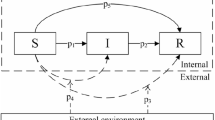Abstract
Epidemics have disturbed human lives for centuries causing massive numbers of deaths and illness among people and animals. Due to increase in urbanization, the possibility of worldwide epidemic is growing too. Infectious diseases like Ebola remain among the world’s leading causes of mortality and years of life lost. Addressing the significant disease burdens, which mostly impact the world’s poorest regions, is a huge challenge which requires new solutions and new technologies. This paper describes some of the models and mobile applications that can be used in determining the transmission, predicting the outbreak and preventing from an Ebola epidemic.
This chapter has been developed by Jesse Shaw and Flavio Villanustre, LexisNexis Risk Solutions, and Borko Furht, Ankur Agarwal, and Abhishek Jain, Florida Atlantic University.
Access this chapter
Tax calculation will be finalised at checkout
Purchases are for personal use only
Similar content being viewed by others
References
Browne C, Huo X, Magal P, Seydi M, Seydi O, Webb G. Model of 2014 Ebola Epidemic in West Africa with contact tracing.
Kouadio KI, Clement P, Bolongei J, Tamba A, Gasasira AN, Warsame A, Okeibunor JC, Ota MO, Tamba B, Gumede N, Shaba K, Poy A, Salla M, Mihigo R, Nshimirimana D. Epidemiological and surveillance response to Ebola virus disease outbreak in Lofa County, Liberia.
Lutwama JJ, Kamugisha J, Opio A, Nambooze J, Ndayimirije N, Okware S. Containing Hemorrhagic Fever Epidemic. The Ebola experience in Uganda.
http://www.imedicalapps.com/2015/04/lessons-ebola-outbreak-using-apps-fight-infectious-diseases/.
Jin F, Dougherty E, Saraf P, Cao Y, Ramakrishnan N. Epidemiological modeling of news and rumors on Twitter.
Anastassopoulou SC, Russo L, Grigoras C, Mylonakis E. Modelling the 2014 Ebola virus epidemic—agent based simulations, temporal analysis and future predictions for Liberia and Sierra Leone.
Merler S, Ajeli M, Fumanelli L, Gomes MFC, Pastore y Piontti A, Rossi L, Chao DL, Longini IM, Halloran ME, Vespignani A. Spatiotemporal spread of the 2014 outbreak of Ebola virus disease in Liberia and the effectiveness of non-pharmaceutical interventions: a computational modelling analysis.
Meltzer MI, Atkins CY, Santibanez S, Knust B, Petersen BW, Ervin ED, Nichol ST, Damon IK, Washington ML. Estimating the future Number of cases in the Ebola Epidemic—Liberia and Sierra Leone, 2014–2015.
Zhang Z, Wang H, Wang C, Fang H. Modeling epidemics spreading on social contact networks.
http://www.who.int/csr/disease/ebola/one-year-report/factors/en/.
Haas CN. On the quarantine period for Ebola virus. PLoS Curr. 2014; Edition 1. doi:10.1371/currents.outbreaks.2ab4b76ba7263ff0f084766e43abbd89.
https://data.hdx.rwlabs.org/dataset/number-of-health-care-workers-infected-with-edv.
http://jmsc.hku.hk/ebola/2015/03/23/fighting-ebola-does-the-mobile-application-help/.
http://who.int/hrh/news/2015/ebola_report_hw_infections/en/.
http://www.math.washington.edu/~morrow/mcm/mcm15/38725paper.pdf.
Chowell G, Nishiura H. Transmission dynamics and control of Ebola virus disease (EVD): a review.
Centola D. The social origins of networks and diffusion. Am J Sociol. 2015;120(5):1295–1338. http://doi.org/10.1086/681275.
Acknowledgments
This work has been funded by the NSF Award No. CNS 1512932 RAPID: Modelling Ebola Spread and Developing Decision Support System Using Big Data Analytics, 2015–2016.
Author information
Authors and Affiliations
Corresponding author
Rights and permissions
Copyright information
© 2016 Springer International Publishing Switzerland
About this chapter
Cite this chapter
Shaw, J., Villanustre, F., Furht, B., Agarwal, A., Jain, A. (2016). Modeling Ebola Spread and Using HPCC/KEL System. In: Big Data Technologies and Applications. Springer, Cham. https://doi.org/10.1007/978-3-319-44550-2_14
Download citation
DOI: https://doi.org/10.1007/978-3-319-44550-2_14
Published:
Publisher Name: Springer, Cham
Print ISBN: 978-3-319-44548-9
Online ISBN: 978-3-319-44550-2
eBook Packages: Computer ScienceComputer Science (R0)




